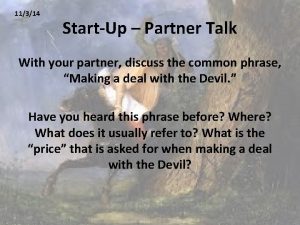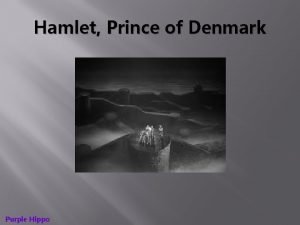Hamlet Warmup With a partner Discuss the kinds












































- Slides: 44

Hamlet

Warm-up! • With a partner: • Discuss the kinds of expectations you encounter on a regular basis. • Consider: – Parents – Jobs – Teachers – Yourself

Where have we been? • Independent Readings – Critical Lenses • • • Feminisim/Gender Marxism/Socioeconomic Lens New Historicism Post Colonialism/Cultural/Racial Lens Moralism Psycholanalytic

Where are we going? • Overarching Question: – What comprises our prisons of expectations? – How do we break through the barriers of societal and personal expectations? – How can different lenses help us break through these prisons?

• Hamlet: What have you, my good friends, deserv'd at the hands of Fortune, that she sends you to prison hither? • Guildenstern: Prison, my lord? • Hamlet: Denmark's a prison. • Rosencrantz: Then is the world one. • Hamlet: A goodly one, in which there are many confines, wards, and dungeons, Denmark being one o' th' worst. • Rosencrantz: We think not so, my lord. • Hamlet: Why then 'tis none to you; for there is nothing either good or bad, but thinking makes it so. To me it is a prison.

How Will It Look? ? • • Dialectical Journals Critical Lens Analysis Play Interp through Lens Socratic Seminar

Hamlet • Talk about a confused guy! – How are we all (a bit) like Hamlet? • Viewing it all through critical lenses – More on that later • Group Notes – Scene performances with critical lenses interpretation • Vocab

Hamlet • Individual Critical Lens Analysis – Interpret elements of the play through a specific lense • • • Feminist Psychoanalytic Moral Marxist New Historicism

Some Themes to Consider • Betrayal • Identity • Corruption • Insanity • Revenge • Grief • Trust • Surveillance • Power

An Introduction to The Tragedy of Hamlet To be, or not to be, that is the question: (III, i, 64 -65) There are more things in heaven and earth, Horatio, Than are dreamt of in your philosophy. (I, v, 186 -187)

• The Tragedy of Hamlet, Prince of Denmark was probably written in 1601. • It is commonly considered to be one of Shakespeare’s greatest works, and, thus… one of the greatest pieces of literature ever written. The Play

ONE

OF

THE

BEST

PIECES

OF

LITERATURE

EVER

WRITTEN!!!!

Hamlet – What’s the situation? • Hamlet is Prince of Denmark • As the play opens he has recently returned to Denmark from Wittenburg, where he is a student. (anachronism). • During his absence from Denmark, his father has died and his uncle, Claudius, has both married Hamlet’s mother and become king. • Hamlet is greatly disappointed that this has all taken place. He is concerned over the moral appropriateness of his mother’s marriage, his uncle’s ascension to the throne, and his own destiny.

The Ghost • Hamlet’s father was also named Hamlet. (We’ll call him OLD HAMLET) • The ghost that appears to Marcellus, Bernardo, Horatio and Hamlet in Act 1 may not be that of Hamlet’s father. It may be an evil being. • It was believed during Shakespeare’s time that ghosts or other spirits could take on any shape they chose for their own evil purposes. • It is important for Hamlet to confirm the true identity of the ghost before he acts on what the ghost tells him or even believes that what it tells him is true.

Claudius • Claudius is Hamlet’s uncle and, as the play opens, becomes his stepfather as well. • Following the death of Claudius’ brother , Old Hamlet, Claudius has become king by election of the nobles. • He seems to be shown acting very much the king in Act 1, scene 2. We may ask if he is noble and decisive from his actions here. • He has also hurriedly married Gertrude, Hamlet’s mother, whom he genuinely seems to love.

Gertrude • Gertrude is Hamlet’s mother and the queen. • Hamlet is very upset that she has married his uncle so soon after the death of his father. • Is there a suggestion of an illicit affair between Gertude and Claudius before the death of the elder Hamlet? • The crowning of Claudius seems to have taken place before Hamlet has had time to arrive from Wittenburg or very shortly thereafter. Gertrude’s marriage to Claudius may have taken place just prior to the entrance in Act 1, scene 2. • In the original legend, she is the queen and her husband became the king. Is this part of the Shakespeare version?

Horatio • Horatio is Hamlet’s friend and confidant. Hamlet suggests to Horatio that he intends to pretend to be insane (1. 5. 171172), and he relates other secrets to Horatio as the play develops. • Horatio, in essence, is present to represent the audience (Greek chorus role) on stage, to ask questions and respond to Hamlet for us. • Hamlet has to explain to Horatio about the customs of the Danes. Is Horatio not a native Dane?

Ophelia • Ophelia is Hamlet’s tragic lady love. • Does Hamlet really love her, despite the cruelty he shows her in Act 3? • How does Ophelia’s virginity affect her status in the play? • Is she strong enough to be the help-mate that Hamlet needs to fulfill his ambition (similar to Lady Macbeth)? • Her madness late in the play models for the audience what real lunacy is, in contrast to Hamlet’s act.

“To put an antic disposition on. . . ” • In Act 1, scene 5, lines 171 -172, Hamlet tells Horatio that he will “perchance… put an antic disposition on. ” • Hamlet is telling Horatio that, he may begin to act strangely, but he will only be feigning insanity. • He then warns Horatio not “to note that you know aught of me” (1. 5. 178 -179)--Hamlet is asking Horatio not to give him away to others by revealing that he is only pretending to be mad.

Insanity • In the pagan world, the insane were thought to be touched by the gods, perhaps even blessed, and were therefore treated kindly, though they were also a little feared. • In Shakespeare’s time, insanity was viewed much differently. Insanity was a punishment for sins, and the insane were greatly maligned.

Madness • In choosing to pretend to be mad, in the pagan sense, Hamlet protects himself from Claudius. • If Claudius were to harm a mad Hamlet, he might displease the gods and thus bring harm to Denmark. • Hamlet buys time by acting mad. He needs time to discover if the ghost is truthful. • Shakespeare depended on his audience knowing the pagan view of madness to explain Hamlet’s decision to pretend to be insane.

Hamlet’s feigned madness • Playing the madman grates on Hamlet. • He is a man of action (1. 5) and a warrior (4. 4 and 5. 2). • Hiding behind this façade conflicts with everything that defines his sense of himself. • It is a hard act to maintain constantly for months. Thus, Hamlet must explain “I am but mad north-west” (3. 2. 381) to excuse those times when the façade slips.

Does Hamlet Contemplate Suicide? • Hamlet is quite often perceived as being on the verge of suicide. Is this accurate? • Hamlet rejects the idea of suicide in 1. 2. 131 -132, as being against God’s will-- “…would… that the Everlasting had not fixed his canon ‘gainst self-slaughter!” • In his most famous soliloquy then, if he is not contemplating suicide, what is he musing about? • Experts disagree on Hamlet’s suicidal intentions

To be, or not to be… • The most famous speech in Hamlet is delivered in scene i of Act 3. • Death, “the undiscovered country, ” is one of the issues to which he speaks. • Having dismissed the idea of suicide in the first scene in which he appears to the audience (1. 2), what else might Hamlet mean when he questions, “To be or not to be”?

The Oedipus Complex • The psychoanalyst, Sigmund Freud, borrowed from Greek myths to name the complexes of human behavior that he identified. • He referred to the physical desire that a son may feel for his mother as the Oedipus Complex. • Because Hamlet seems obsessed with his mother’s behavior, some audiences interpret this as evidence that he suffers from the Oedipus Complex • Does this reveal a flaw in Hamlet’s character, or is there a different meaning to his comments?

Oedipus • Oedipus was a Greek hero and king. It was prophesized that he would kill his father and marry his mother, so he was sent away to be killed at birth. As in many such stories, the person charged with his murder could not carry it out. Oedipus grew up to fulfill the prophesy.

How Old is Hamlet? • He has returned home from the University of Wittenburg. This suggests he is fairly young, perhaps 19 or 20. • His youth may have kept him from the crown • In the scene above (5, 1), Hamlet is looking at the skull of Yorick, the jester, who “hath borne me on his back a thousand times. ” • In this same scene, the First Clown, says he has held his job since the young Hamlet was born, or for “thirty years. ” • Yorick has been in the grave “three and twenty years. ”

Hamlet’s Age • The rest of the play strongly supports the depiction of Hamlet as a young man. There a couple of reasonable explanations, and even a rather far-fetched one, to account for this discrepancy: • An uncorrected transcription error that has existed for nearly 400 years ago and is now part of the canon. • Shakespeare created it as an “excuse” to allow an older actor play the role of the young Hamlet. • The Hamlet of Act 5 is significantly different from the Hamlet of the rest of the play. Is it symbolic of the change?

Indecisive or a man of action? Hamlet is sometimes criticized for moping around the castle instead of just killing Claudius and seizing the crown. Consider these points: • To kill the king without cause would be regicide and would not gain Hamlet the throne. • Hamlet wants revenge, but he also wants the throne. • He does take immediate action in choosing to feign madness to buy himself time. • He needs the time find out if the ghost is honest and to prove Claudius murdered his father.

What Hamlet wants: • “He that hath killed my king, whored my mother//Popped in between th’ election and my hopes//Thrown out his angle to my proper life” (5. 2. 64 -66). Hamlet tells the audience exactly what he wants in this and at least two earlier scenes. • He wants – The crown – Revenge for the murder of his father – To somehow restore his mother’s lost virtue

Sources of Hamlet • Hamlet is based on the story of Amleth in Danish mythology. That character feigns madness in order to avenge his murdered father. • Subsequent versions of the story and plays introduced additional elements that are also found in Shakespeare. • Shakespeare chose to make the murder of the father a secret and to use the ghost to reveal it to the son.

Amleth • The story of Amleth is a revenge tragedy, but it also is in the category of the Hero as Fool tradition. • In these stories, the hero pretends to be witless or insane, but his encounters with others show he is much more clever than they, and he triumphs by virtue of his wits.

Women in Hamlet • As a widow, Gertrude would have left the court and been relegated to a small house as the dowager queen. Marrying Claudius, the new king, allows her to maintain her title as queen. What does this say about her character? ? • Ophelia was a young, unmarried woman who is completely dependent on her father. She is expected to be obedient and reject Hamlet’s advances. She also reports to her father about Hamlet’s behavior. Although she is desperate to be loyal to Hamlet, she must obey Polonius. Have Hamlet and Ophelia consummated their relationship? How would this affect her status and her state of mind?

Shakespearean Tragedy • Shakespeare follows Aristotle’s formula for tragedy, including catharsis – allowing the audience to experience the pity, sympathy, fear, and horror the characters feel. • Hamlet as a protagonist is a man of inner strength and greatness, despite his indecision. • Intrigue, denied love, realistic action, secret murder, war preparations, drinking, traveling to far off places all contribute to the excitement of the play.

Shakespeare’s Tricks • Anachronism – something that is historically out of place. Example: Hamlet, a 7 th century Dane, is a student in Wittenberg, a university founded in 1502. Allows audience to identify with characters – shows Hamlet as a scholar and a skeptic where ghosts are concerned. • Imagery – Claudius’s Denmark is associated with corruption and disease; Hamlet wears an “inky cloak” of grief; Hamlet associates all women with “makeup” or artifice – hiding their true faces.

Works Cited Asimov, Isaac. Asimov’s Guide to Shakespeare. New: York: Doubleday, 1970. GMT- Pygmalion. 14 Sep. 1999 http: //www. gmtproductions. com/hamlet. htm. “Hamlet. ” Legends- Shakespeare. 14 Sep. 1999 http: //www. legends. dm. net/shakespeare/hamlet. html. “Richard Bebb Figures. 14 Sep. 1999 http: //village. vossnet. co. uk/o/owenw/olioedi. htm.
 Discuss these questions with your partner
Discuss these questions with your partner Discuss these questions with a partner
Discuss these questions with a partner Discuss these questions with a partner.
Discuss these questions with a partner. Discuss these questions with a partner
Discuss these questions with a partner Amateurs talk strategy professionals talk logistics
Amateurs talk strategy professionals talk logistics Java warmup
Java warmup Warmup ratio
Warmup ratio Warmup end
Warmup end Pyramid warmup
Pyramid warmup Define:warmup
Define:warmup Warmup 65
Warmup 65 Monorhyme
Monorhyme Tinman endurance coaching
Tinman endurance coaching Pathos story
Pathos story Gmass warmup
Gmass warmup Adding exponents rules
Adding exponents rules Warmup 65
Warmup 65 Stratified warmup
Stratified warmup Thể thơ truyền thống
Thể thơ truyền thống Chúa yêu trần thế alleluia
Chúa yêu trần thế alleluia Hổ đẻ mỗi lứa mấy con
Hổ đẻ mỗi lứa mấy con Diễn thế sinh thái là
Diễn thế sinh thái là Vẽ hình chiếu vuông góc của vật thể sau
Vẽ hình chiếu vuông góc của vật thể sau Công của trọng lực
Công của trọng lực 101012 bằng
101012 bằng Tỉ lệ cơ thể trẻ em
Tỉ lệ cơ thể trẻ em Thế nào là mạng điện lắp đặt kiểu nổi
Thế nào là mạng điện lắp đặt kiểu nổi Lời thề hippocrates
Lời thề hippocrates đại từ thay thế
đại từ thay thế Vẽ hình chiếu đứng bằng cạnh của vật thể
Vẽ hình chiếu đứng bằng cạnh của vật thể Quá trình desamine hóa có thể tạo ra
Quá trình desamine hóa có thể tạo ra Môn thể thao bắt đầu bằng chữ đua
Môn thể thao bắt đầu bằng chữ đua Hát kết hợp bộ gõ cơ thể
Hát kết hợp bộ gõ cơ thể Khi nào hổ mẹ dạy hổ con săn mồi
Khi nào hổ mẹ dạy hổ con săn mồi Các loại đột biến cấu trúc nhiễm sắc thể
Các loại đột biến cấu trúc nhiễm sắc thể Thế nào là sự mỏi cơ
Thế nào là sự mỏi cơ Trời xanh đây là của chúng ta thể thơ
Trời xanh đây là của chúng ta thể thơ độ dài liên kết
độ dài liên kết Chó sói
Chó sói Thiếu nhi thế giới liên hoan
Thiếu nhi thế giới liên hoan Vẽ hình chiếu vuông góc của vật thể sau
Vẽ hình chiếu vuông góc của vật thể sau điện thế nghỉ
điện thế nghỉ Một số thể thơ truyền thống
Một số thể thơ truyền thống Thế nào là hệ số cao nhất
Thế nào là hệ số cao nhất Hệ hô hấp
Hệ hô hấp




































































